If there is one thing we can be sure of in New Zealand publishing, it’s that there will be at least a dozen kiwi books published over the year. This batch of reviews includes three books including kiwi that are a cut above, as well as a new book by Stephanie Thatcher featuring a very monstrous mummy.
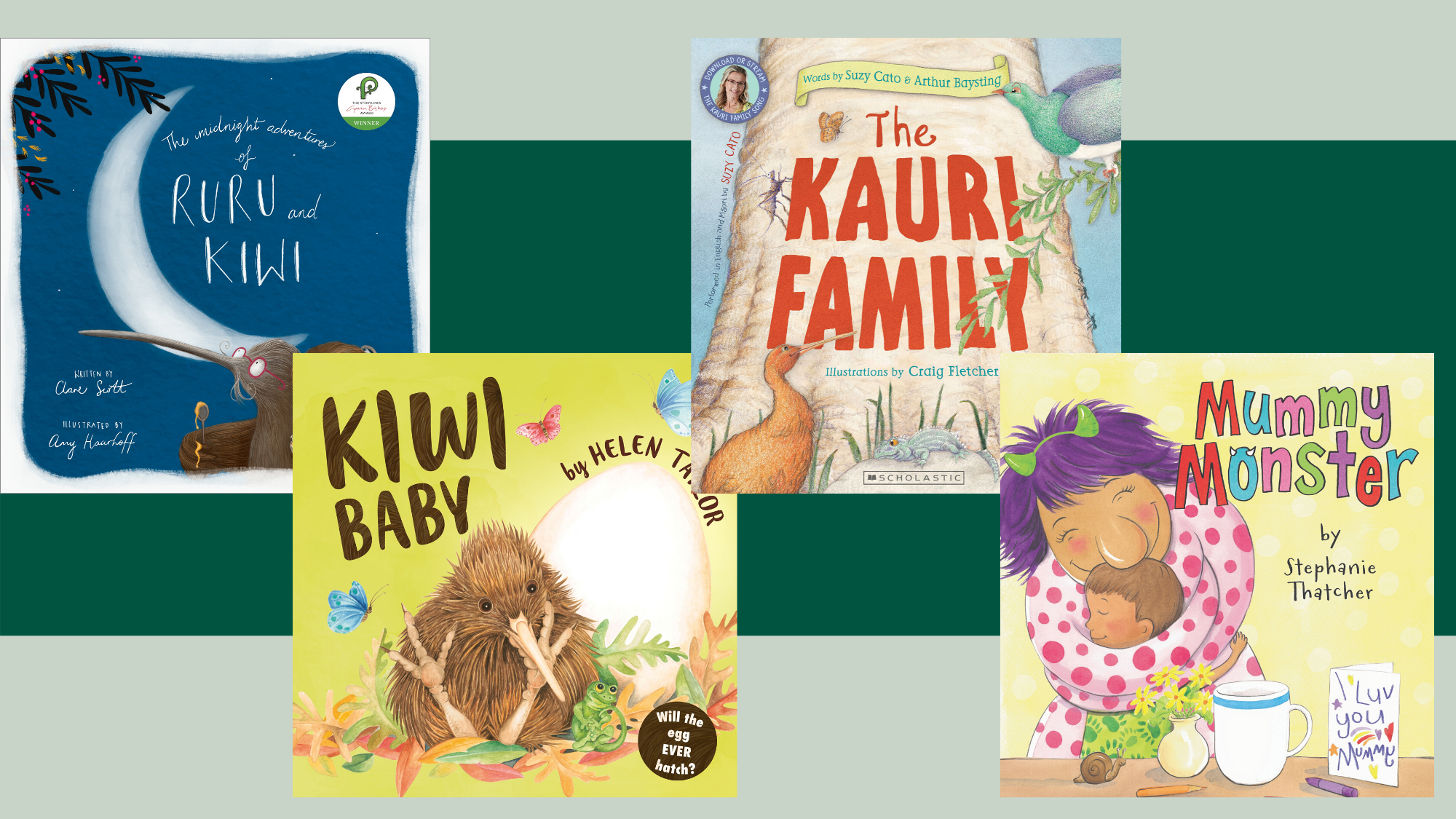
The Midnight Adventures of Kiwi and Ruru, by Clare Scott, illustrated by Amy Haarhoff
This book tells the story of kiwi and ruru, to the tune of classic poem ‘the owl and the pussycat’, bringing in animals you may find out and about at night in Aotearoa.
It’s a wee bit of an assumption that the parent reading this will know the correct rhythm for the read-aloud, but once you get in the swing of it, it’s a really fun read that will bring a smile to your kids’ faces.
…it’s a really fun read that will bring a smile to your kids’ faces.
One of my favourite things about this book is that you really need to make an effort to pronounce your te reo words correctly to make it sing. Here’s an example: if you didn’t know the mānuka had a slightly longer ‘a’, the rest of the line would be flat.
‘They took some runny
mānuka honeyTied up in a flax-woven sack.’
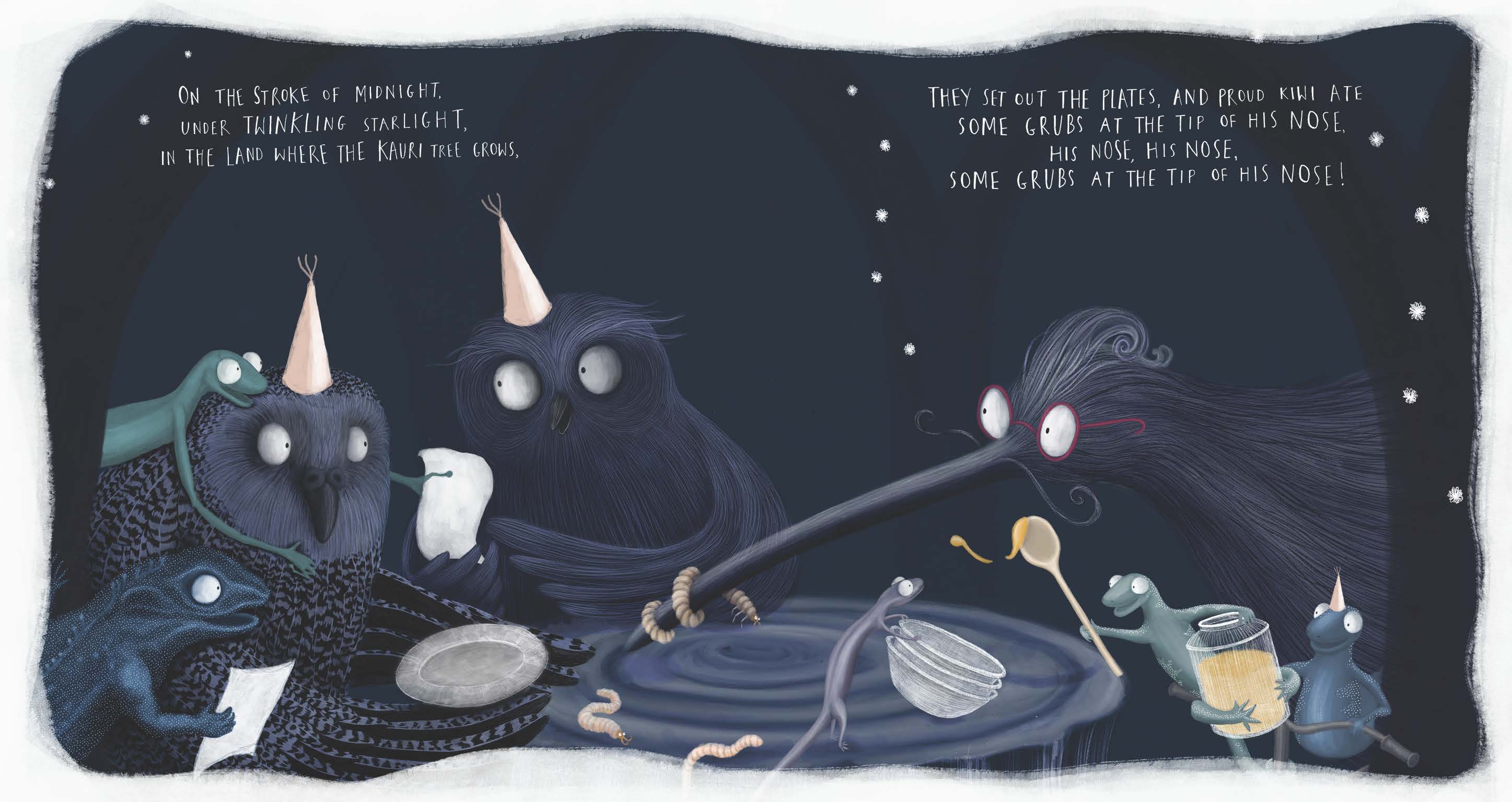
The story is told well, with some beautiful turns of phrase, like ‘He draped rātā vines over ponga and flax, nīkau, and pūriri too. “Send out the invites for our feat by moonlight, we’ll throw a great party we two, we two, we two, we’ll throw a great party, we two!”’ There are a couple of dodgy scans, and odd choices to make it all work, but I feel as though this is nearly unavoidable when you are working with a rhythm you didn’t originate.
I love the motion in Amy Haarhoff’s illustrations, with Mr Kiwi balancing on one leg in excitement as he decorates the forest, and the tiny skinks zooming to the party on their little bikes. So clever! And challenging, to decide to draw a skink on a bicycle, a tricky thing for any illustrator, let alone a first-time illustrator.
Amy Haarhoff won the Gavin Bishop Award for her initial illustrations for this book, and with her skill in drawing native animals, and her excellent use of very on-trend colours, I think she has a long future ahead of her. One of the best illustrations is the kōwhai tree in bloom by the light of the crescent moon: just divine.
Amy Haarhoff won the Gavin Bishop Award for her initial illustrations for this book, and with her skill in drawing native animals, and her excellent use of very on-trend colours, I think she has a long future ahead of her.
The production values of the book make it one to pick up off the shelf, with a glow-in-the-dark title and author and illustrator names, and good paper selection. I didn’t really enjoy reading the font, with its spiky all-caps uneven depth, but as I think this is destined as a read-aloud, rather than a read-alone, this works with the aesthetic of the book perfectly.
Recommended for a library read-aloud, perhaps in a sleepover in the library or bookshop once COVID-19 is gone for good!
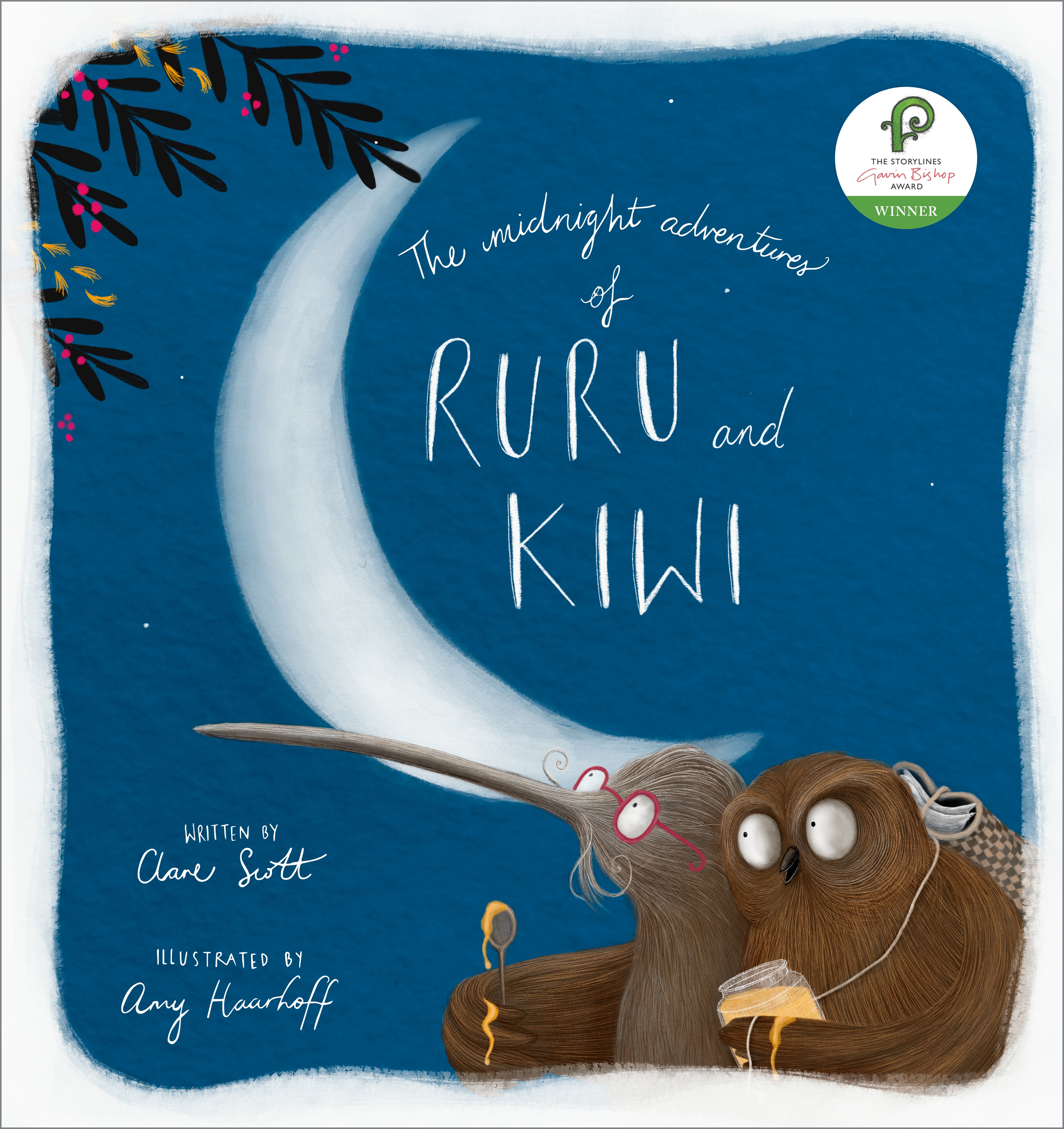
The midnight adventures of ruru and kiwi
by Clare Scott
Illustrated by Amy Haarhoff
Penguin Books NZ
RRP $19.99
Kiwi Baby, by Helen Taylor (Puffin)
This is a beautiful baby sibling story from well-established author Helen Taylor, known for Kakapo Dance and other books featuring New Zealand’s wildlife.
Kiwi Iti wakes up and something is different – there’s an egg in his nest. Something is about to change, so he goes to talk to his dad Kiwi Nui about it. Kiwi Nui is, of course, the main carer for the egg during its gestation, so this book is teaching young kids about how kiwi look after their young, as well as teaching them the value of patience.
Kiwi Iti has a lot of questions, as do many siblings-to-be – I still remember my eldest’s impatience as he waited for his younger brother to be able to play with him ‘properly’. It’s a lot for a little kid to understand, and the gentle refrain ‘Not yet, Kiwi Iti, these things take time,’ is eventually answered with ‘What is time?’ And it was Kiwi Nui’s turn to think.
It’s a lot for a little kid to understand, and the gentle refrain ‘Not yet, Kiwi Iti, these things take time,’ is eventually answered with ‘What is time?’ And it was Kiwi Nui’s turn to think.
The illustrations are beautiful and soft, with fanciful butterflies floating around, and a gecko on most pages. The feathers of the kiwi are touchably fluffy, and the cracks in the egg as Kiwi baby emerges and joins the family are gradual and tell the story of time passing well.
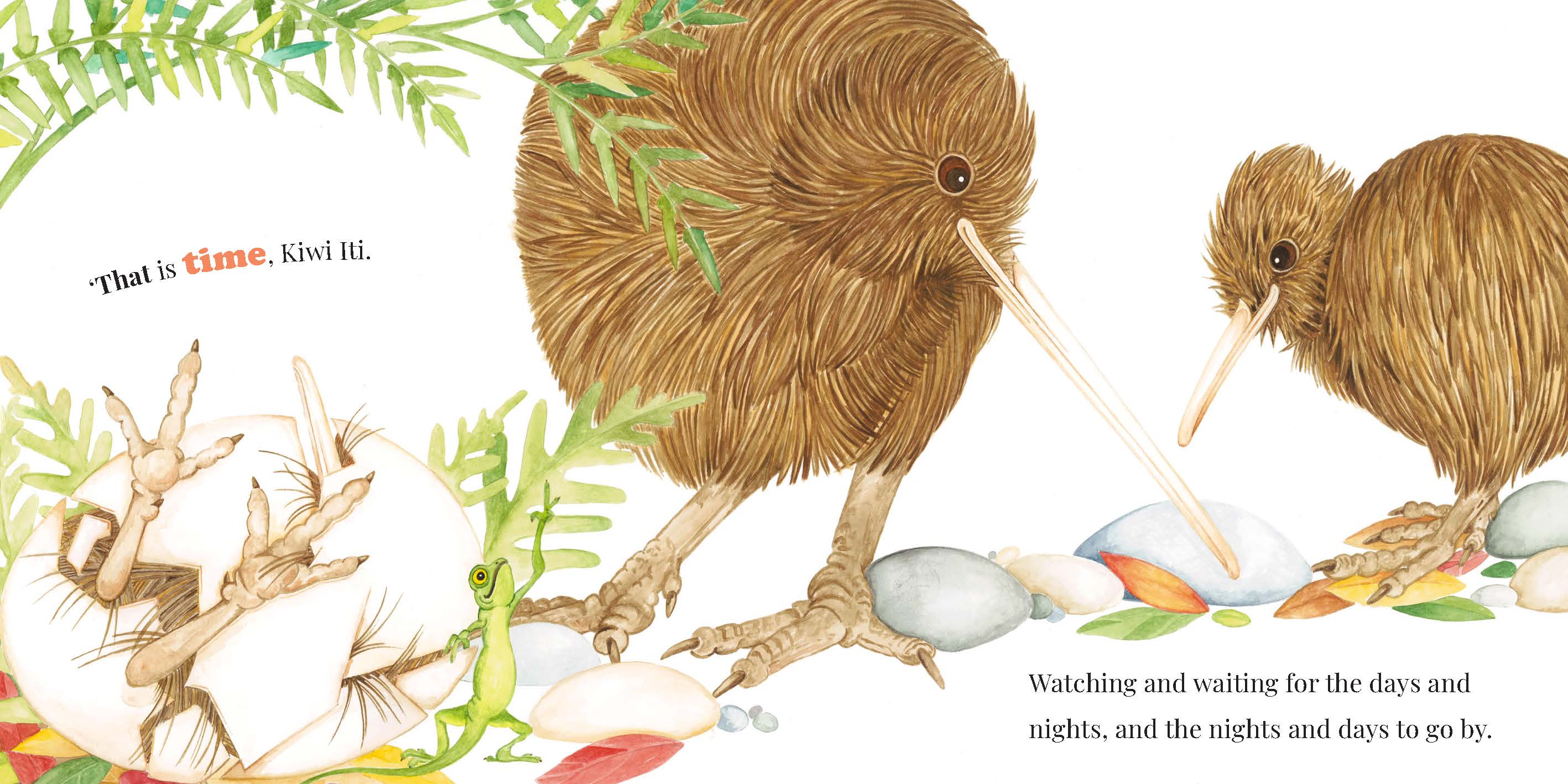
I think this book fills a couple of gaps—there hasn’t been a new sibling story by a Kiwi author in awhile by my reckoning, and a kiwi is a lovely exemplar of a family where the male is the sole nurturer, something that is not very often seen in picture books.
I think this book will quickly become a backlist favourite as the years go by, for kids aged 2–5 who are expecting a little sibling. I also think it would be worth putting into a board book format. Recommended.
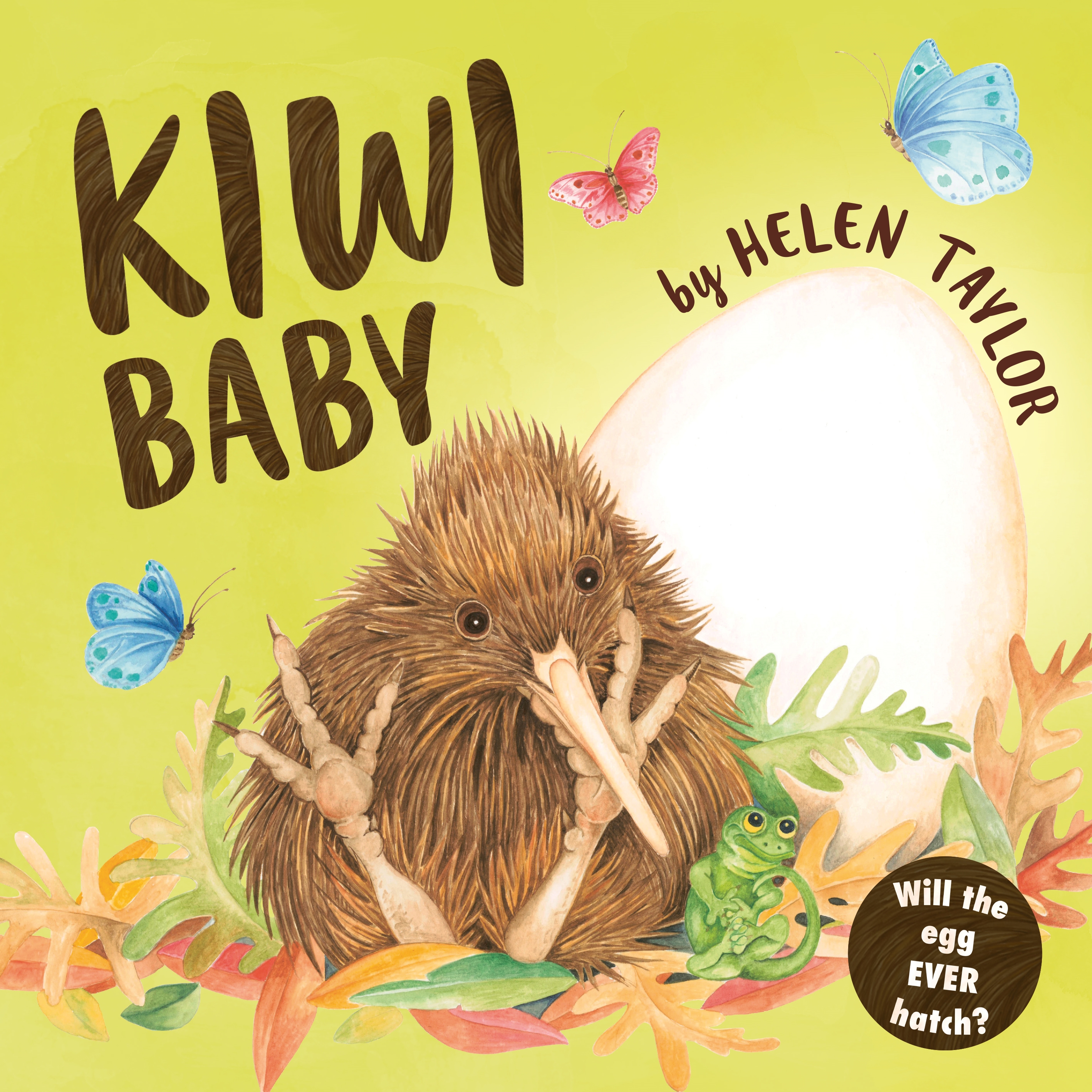
The Kauri Family, by Suzy Cato and Arthur Baysting, illustrated by Craig Fletcher (Scholastic NZ)
It can be hard to tell another New Zealand nature story without it feeling like just another in an already saturated NZ-bird-focused picture book market, but I think that Suzy and the late Arthur Baysting have pulled this one off admirably. As I read this aloud, my nine-year-old got into the spirit of the story, and thoroughly enjoyed beating me to guessing the inhabitants of this Kauri tree.
Many books focus on the broader bush life, so it is lovely to see such a close focus on one of New Zealand’s most glorious giant trees, which is at the centre of the thriving ecosystem we see in the book. Each creature interacts with the Kauri tree for something it needs, whether this is food, nutrients, undergrowth, or bark to camouflage against.
‘What’s that there, can you see?
I wonder what that thing can be.
Now it’s climbing up the tree!
It’s part of the Kauri Family.’
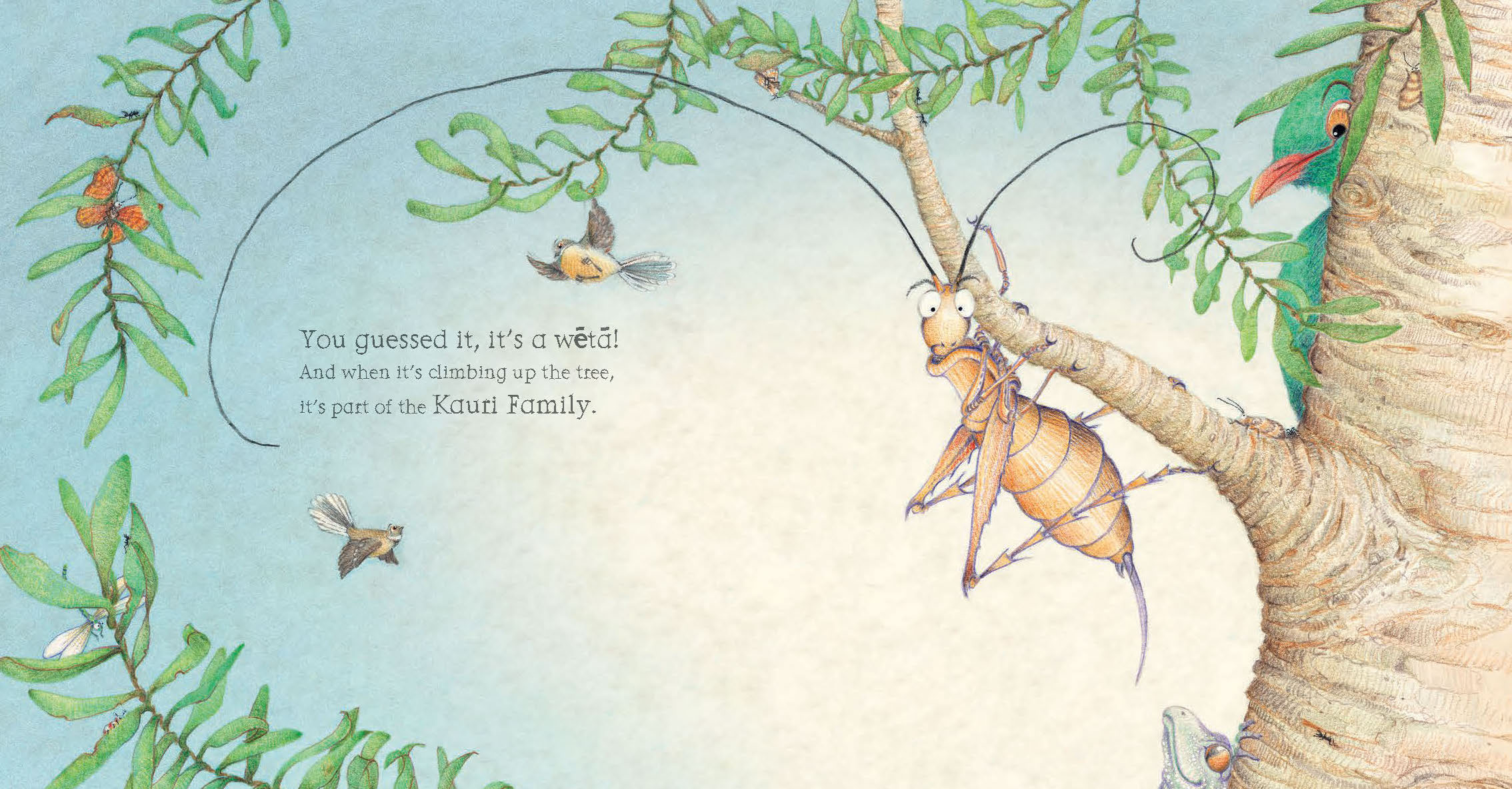
This is the refrain of the song, which can be downloaded via a myriad of online shops for free – huzzah, no more pesky CDs with one song on them! This has been a bugbear of mine for so long, so I’m delighted to see Scholastic NZ moving into the new age of music delivery.
The illustrations are soft and gentle-looking, with my favourite being the Kereru, with its cheeky orange eye. The kiwi was a long-necked lean looking thing, a far cry from Kiwi Baby’s fluffy creature, but the trademark pencil-like beak won me over.
This is going to be a regular go-to for storytellers in libraries across the country. Recommended for kids of all ages.
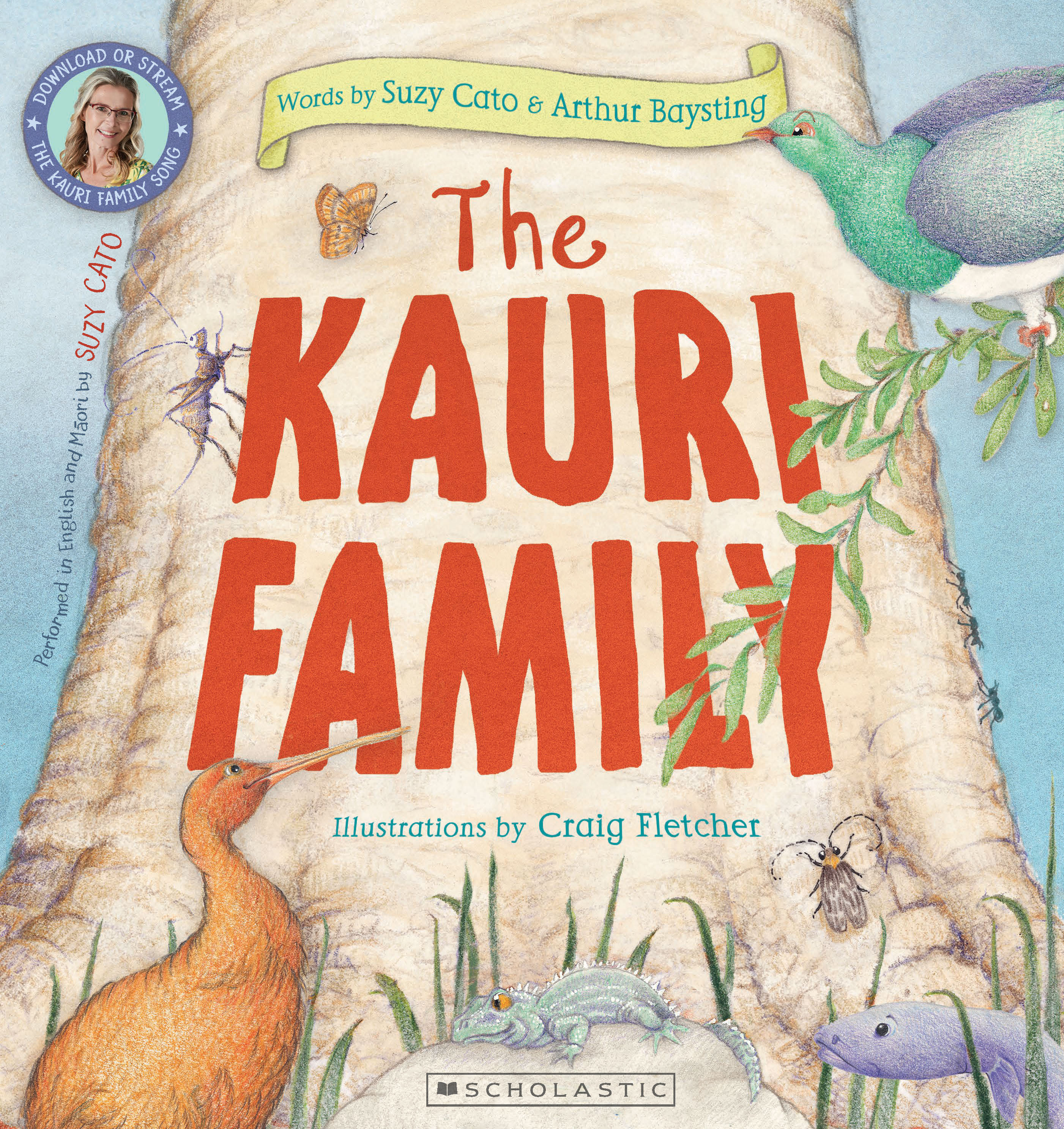
the kauri family
by Suzy Cato and Arthur BaystingIllustrated by Craig Fletcher
Scholastic NZ
RRP $18.00
Mummy Monster, by Stephanie Thatcher
I have struggled over my years as a mother to find a book about mothers that I like, published here or anywhere. I still haven’t found my golden goose, but there is a lot to like about Mummy Monster (though due to COVID-19 it just missed it’s Mother’s Day publication date!)
I’ll start with the negatives so I can work my way to the good bits! What the mummy is doing throughout the book bothers me for its domestic focus. It isn’t Anthony Browne’s My Mum level of double-standards, but it is quite narrow in its outlook, as she cleans the oven of an evening. That said, it is showing the emotional and physical side of being a mum-at-home, and possibly a solo mum, which is great to see.
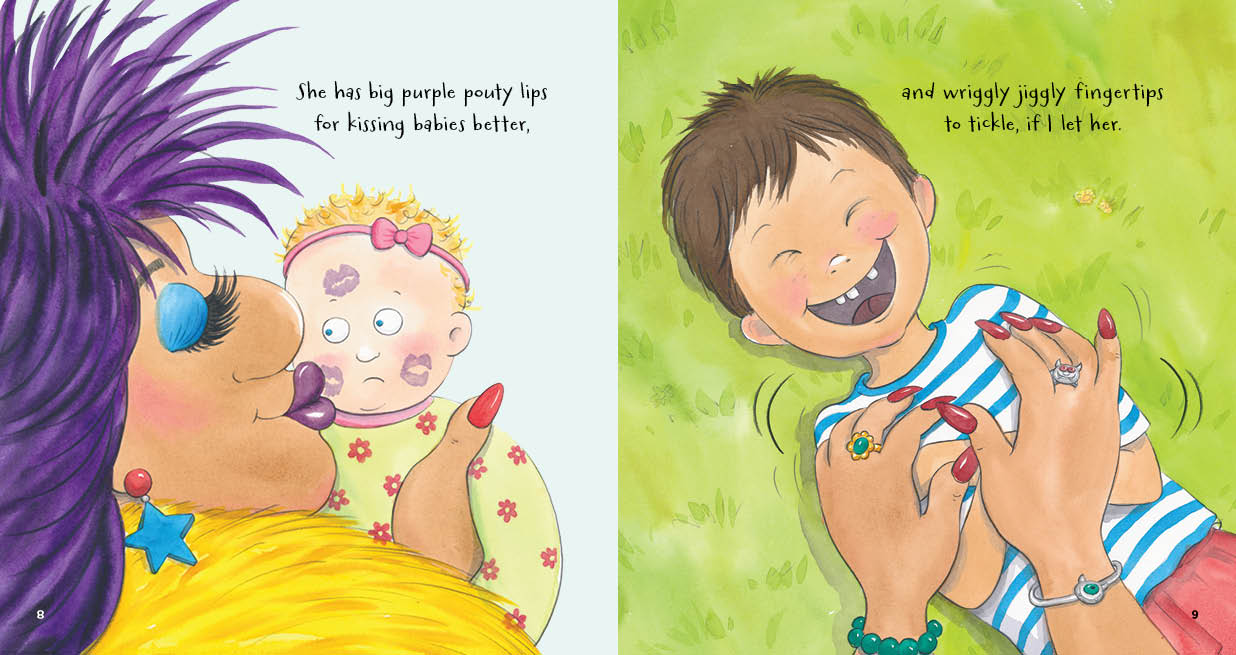
‘She has big purple pouty lipsFor kissing babies better,And wriggly jiggly fingertipsTo tickle, if I let her.’
The language uses assonance as well as rhyme throughout, and it scans well, making for a smooth read. I enjoyed some the scene where mum has to grow to defend her son, but my favourite scene was the one at the end, where all the different types of mummies are shown, in all shapes, skin colours, and sizes, and with some excellent haircuts.
The language uses assonance as well as rhyme throughout, and it scans well, making for a smooth read.
I enjoyed Thatcher’s illustration style, with the spot-the-monster game all the way through with mummy’s jewellery and clothes. Mummy the monster is very extra, and very cuddly, and the love in the story shines through.
I think there are plenty of mums, and plenty of kids that will adore this story, for its fierceness and its fun. For ages 2+.
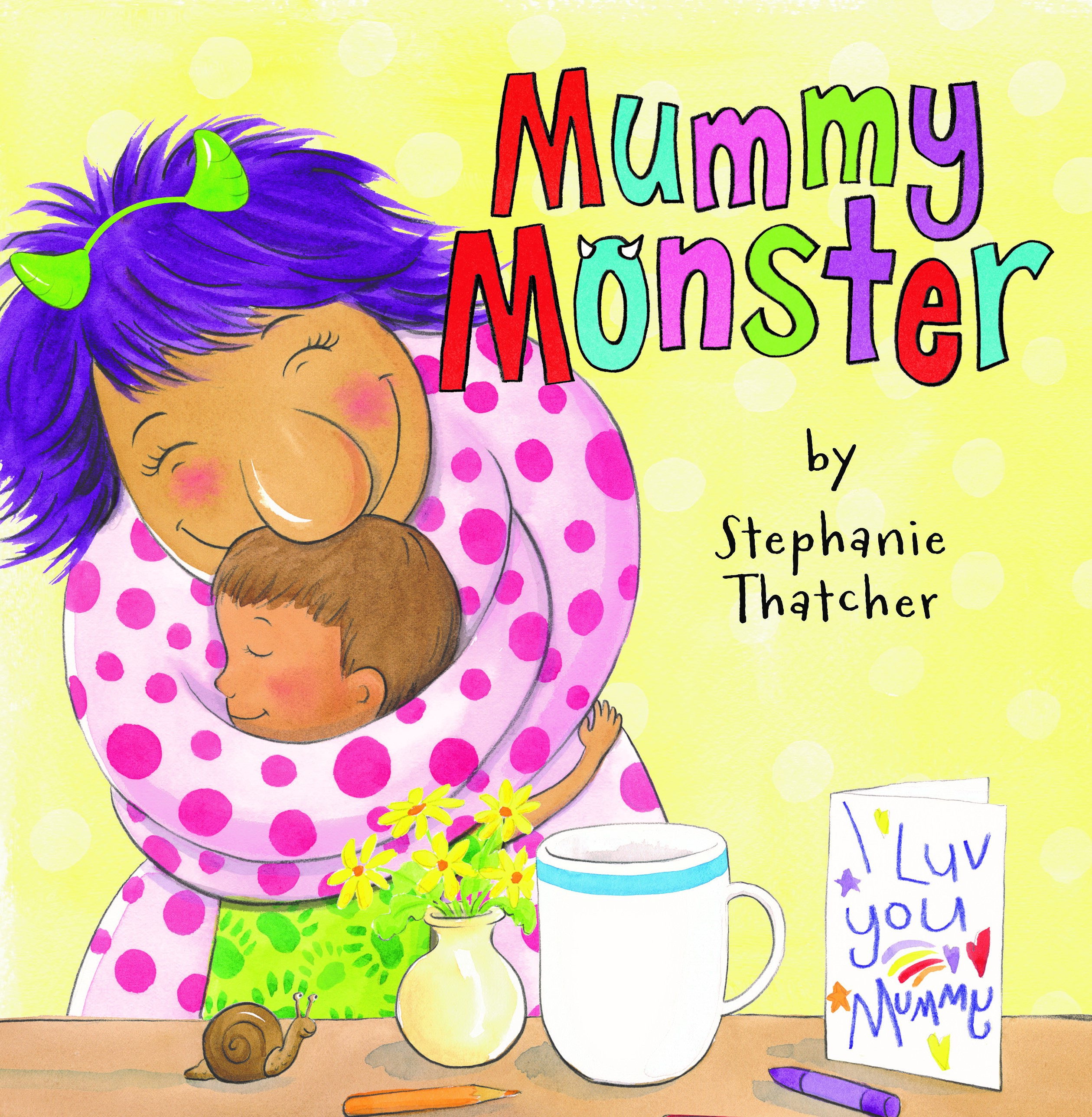

Sarah Forster has worked in the New Zealand book industry for 15 years, in roles promoting Aotearoa’s best authors and books. She has a Diploma in Publishing from Whitireia Polytechnic, and a BA (Hons) in History and Philosophy from the University of Otago. She was born in Winton, grew up in Westport, and lives in Wellington. She was a judge of the New Zealand Book Awards for Children and Young Adults in 2017. Her day job is as a Senior Communications Advisor—Content for Te Herenga Waka—Victoria University of Wellington.



